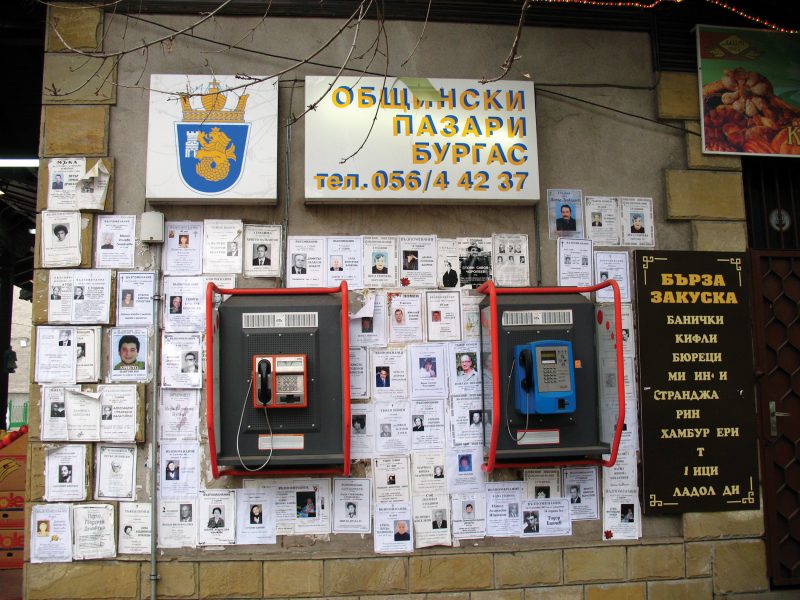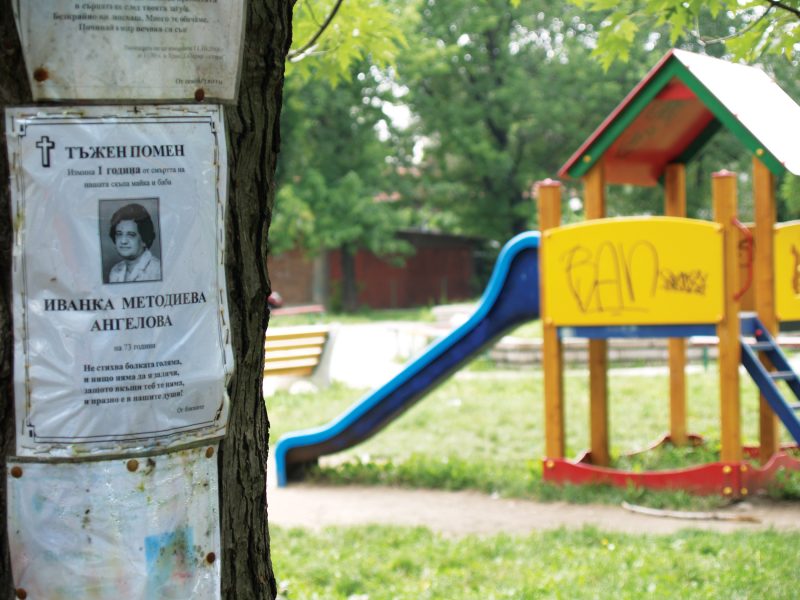I.
I was five when my grandmother Parashkeva first took me to a funeral. She was the mayor of a small village in northern Bulgaria, and one of her responsibilities was to read eulogies for her dead constituents. Priests were no longer welcome back then, with their mumbling promises of a better world (what could be better than life in the People’s Republic of Bulgaria?), so my grandmother became a secular priestess of sorts, a female Pericles. She married people and she buried them.
I remember my first body, laid out in a simple casket propped on two chairs in the garden of the dead man’s house. Dressed in a black suit, he had a burning taper stuck in his lap, wax dripping onto his hands. It was a hot summer, the ripe tomatoes in the vegetable patch glowing bright as embers. A few black-veiled women wailed softly by the coffin, one of them swatting the gathering flies with the loose ends of her headscarf. I was standing at the head of the attending crowd, holding on to my grandmother, mesmerized, while she read out the eulogy she had written earlier that day on stationery paper. Her voice was clear in the heat, formal and martial, the voice of a schoolmarm tackling a patriotic poem. The wailing grew louder as she praised the dead man, his useful life as a mechanic, his good standing in the Communist Party.

An open trailer draped in black hitched to a red farm tractor pulled up next to the house. In one smooth motion the pallbearers shouldered the casket and loaded it onto the flatbed, then helped the veiled women climb up.At an invisible signal, the tractor revved its engine, shot up a plume of exhaust, and jerked forward. Staggering, three gypsy brass players took up a drunken version of Chopin’s funeral march with the mourners following on foot behind them. At every bump in the road, the tractor-trailer jolted and shook out forgotten grains of wheat onto the cracked blacktop.
II.
My first dead man has been resting in the soft, fertile loam of northern Bulgaria for almost twenty-five years now, but each time I go back to my grandmother’s village, his face is still there, on the front door of his former house, on the fragrant lindens, on the old telegraph poles, staring at me from the windows of the general store and the shuttered bakery. He is clean-shaven and officious, youthful looking, his eyes ruefully fixed upon some invisible object in the distance.
This is not a gothic tale. There is nothing particularly ghostlike about those sheets of A4-size paper with a passport-size photo of the deceased—the fluttering, flimsy miniature tombstones are just necrologues.
III.
Necrologues are street obituaries that announce or commemorate the passing of a member of the local community. mournful news, the black header says, or farewell, or sorrowful remembrance. The loose leaves quickly yellow in the sun and molder in the rain—but their sheer numbers safeguard their existence. Among posters for the upcoming concerts of Madonna and Elton John, among homemade ads offering English-language lessons and weight-loss recipes, peek out thousands of lusterless eyes. Some municipalities have tried to contain the spread of necrologues by allotting special bulletin boards for that purpose, but all efforts to sanitize and discipline urban spaces have come to naught. The eternal border between the upper world and the underworld, the city and the cemetery, has disappeared in Bulgaria. No one is truly dead without a necrologue, and yet necrologues are meant to keep the dead alive. As long as the photographic image of the deceased lasts, as long as passersby are willing to stop to look at that face and read the name, death has no dominion. “The life of the dead is placed in the memory of the living,” Cicero once told the Roman senators, when trying to convince them to erect a bronze statue in honor of his late friend Servius Sulpicius Rufus. Memory has always been death’s most dangerous adversary.
IV.
Monastic institutions and churches recorded the names of their illustrious dead (kings, abbots, benefactors) in special registers called necrologies. On certain days of the year, these death-rolls would be read out loud during service as both commemoration and prayer, for the road to salvation lay through the gates of memory. A soul could be easily lost if her name was forgotten.
Necrologues and obituaries trace their roots to that tradition. By the mid-nineteenth century many European and American newspapers had sections dedicated to the dead. Some were simple death notices, marking the date and circumstances of the passing, while others were elaborate biographical portraits of luminaries and celebrities, like the famous eulogy Emerson wrote for Thoreau in 1862: “His soul was made for the noblest society; he had in a short life exhausted the capabilities of this world; wherever there is knowledge, wherever there is virtue, wherever there is beauty, he will find a home.”
It was around that time, with the ever-growing power and availability of printing technologies such as the steam-powered press (invented in 1814) and the rotary printing press (1843), that death burst through the bounds of newspapers and spilled out into the streets and squares. Few people today are aware that in the second half of the nineteenth century there were street obituaries in Paris and Vienna, London and Rome. Necrologues were hip; to die a modern death one had to have a necrologue. As late as 1957, the town of Santa Maria, California, was trying to deal with the proliferation of funeral notices in public places. Following the contemporary trend to censor morbid images, local officials finally outlawed the practice.
Today necrologues still survive in some Balkan countries, and Italy and Israel have their local versions as well, but only in Bulgaria do the dead outnumber the living. Necrologues were, ironically, a fashionable borrowing from Western Europe, a way for Bulgarians—liberated in 1878 from the clutch of the dying Ottoman Empire—to announce to the world their birth as a modern nation. There, necrologues thrived.
V.
In 1897, Hariton Ignatiev published A Detailed Epistle, in which he prescribed a structure for necrologues. They should include, he wrote,
The names of all close relatives of the deceased, even the youngest ones;
All distant blood relatives, as well as information pertaining to their children;
Their names, nicknames, and the nature of their relation to the
deceased;What kind of illness—prolonged or swift, severe or painless—was the cause of death;
What was the age of the deceased;
The day and hour of death;
The day and hour the body will be taken out of the house;
The church where the service will be held;
If the deceased is not well-known, his/her house and street number.
The death notice, which Ignatiev also called “a funeral invitation,” was to be printed on a sheet of paper with black borders, a Christian cross or an allegory of death on top. He also advised the use of cheaper paper when the deceased was an older person, and glossier varieties for the youngest.
VI.
When the communists took over the Bulgarian government in September 1944, they banned newspaper obituaries, deeming them too morbid and backward for the brave new world they planned to build. Unable to get rid of the sting of death entirely, at least not at that socioeconomic stage of development, they did allow street necrologues to survive. For weren’t they like the holy icons of the proletariat, every dead worker a pedestrian saint in disguise?
In 1949, the Bulgarian navy published a rather elaborate necrologue on the death of Georgi Dimitrov, the first communist leader of Bulgaria, whose embalmed body lay for the next forty-one years in a glass coffin in a mausoleum in downtown Sofia.
With a heavy heart, the officers of the Bulgarian Navy learned of the sad news affecting our whole nation and all progressive humanity: the death of our beloved teacher and leader GEORGI DIMITROV.
In these decisive times, when our nation is straining every sinew to build Socialism in our country, we painfully feel the loss of the one, who led, inspired, and instructed us in the struggle for peace, democracy and socialism.
We don’t despair in this cheerless moment, but like a granite rock we stand steadfast behind our favorite Central Committee of the Bulgarian Communist Party, the defender and heir to the work for which our eminent DIMITROV fought and toiled.
We PLEDGE and stand under the OBLIGATION to do everything possible to strengthen the solidarity of our combat units, learning from the rich inheritance DIMITROV left to us—his living example and work.
We promise to raise to the highest level our combat and moral-political readiness; we won’t spare our strength and life to make DIMITROV’s work a part of life.
We will work relentlessly and tirelessly to learn from the rich experience of the MIGHTY SOVIET UNION—our defender and teacher, under the wise leadership of the mighty STALIN.
We promise to preserve the eternal friendship between our people and the other democratic peoples, led by the mighty and majestic Soviet Union, the way comrade Dimitrov instructed us.
We promise to guard like the pupils of our eyes our maritime border for the successful building of socialism in our beloved Motherland.
DIMITROV DIED, BUT HIS WORK WILL LIVE FOREVER!
VII.
By the end of the 1950s, with the growing availability of photography, the streets began filling with ever-greater numbers of necrologues. Left with no other meaningful funeral rites, Bulgarians enthusiastically embraced them as the only available prayer for the dead. The bereaved now added commemorative notices to honor family and comrades who had passed away three and six months ago, one and two and three and five and ten years ago. Often, there were separate necrologues from family, coworkers, and institutions.

Of course, the genre required a few political modifications. The cross at the top of the page was replaced with the communist star, or, if the deceased happened not to be a member of the Communist Party, the space was left blank. Second, the textual template needed to reflect the new atheistic values. Death became a manifesto, gushing about the merits of the laborer and the inconsolable pain resulting from the loss of productivity. “Today one workplace was left unoccupied,” said one necrologue from that era.
History returned the joke in kind. After the communist government passed away, on November 10, 1989, someone pasted the following necrologue in downtown Sofia:
A full three months have now passed since we parted with our beloved Bulgarian Communist Party. We lost forever our dear mother, sister, and relative. We lost all purpose and the meaning of our lives, our bright future. Only the memory of the beautiful past remains: the red-colored memory of our dreams and hopes. Dear Party, our grief is great and inconsolable. Time is unable to heal this sorrowful separation. The memory of you, oh, dear Party, will rest in our hearts forever.
VIII.
Without its photograph, a necrologue would be just an epitaph, writing on the wall. It is the photograph of the face—there, but not there—that captures the ghost of death in all of its peculiar pathos. In a sense, all photographs are necrologues by default, elegies to that which has already passed; the necrologue simply exposes the essence of the photograph. “All photographs are memento mori,” writes Susan Sontag in her book On Photography. “To take a photograph is to participate in another person’s (or thing’s) mortality, vulnerability, mutability.” And Roland Barthes, in his very personal Camera Lucida, makes a similar observation. “Death,” he says, “is the eidos of the photograph.” He goes on to discuss the photo of a young man, Lewis Payne, who was condemned to die in 1865 for his attempt to assassinate the United States secretary of state William H. Seward and for the assassination conspiracy against Abraham Lincoln. Handsome and handcuffed, Payne is looking boldly into the camera, as if challenging time itself. “He is dead,” Barthes writes in the caption, “and he is going to die.”
IX.
The textual framework of necrologues has always been a source of literary mystery for me. It is not uncommon to see two adjacent necrologues replicate the exact same content: just a few formulaic lines of verse or prose about love, sorrow, and memory.
You left but didn’t say “good-bye,”
You started on the road alone,
You left the pain alone to us
And all the words you didn’t say.
Or
Where are you?
Did you drown into the swell of the sea,
Or did time engulf you in its folds
Or did the wind sweep you away?
But how should I believe you’re there
When you’re in my heart?
Or
Nobody really dies
Until the living
Love and remember.
But who writes these poems? Is there some great elegist, a Balkan Tennyson, churning out in-memoriam stanzas in his creaky attic? Funeral homes keep thick catalogs full of poetic kitsch for their clients’ convenience, from which one could choose the rhyme that fits one’s grief. I visited a couple of them by Sofia’s Central Cemetery to look for answers, but nobody could tell me anything specific. “We just photocopied the catalog from our colleagues, and they photocopied it in turn from their colleagues” was the most frequent response I got. The original source, like that of a medieval manuscript, seemed to have been lost somewhere back in time immemorial.
X.
In her article “The Fabric of Pain,” the Bulgarian sociologist Emiliya Karaboeva came up with a set of statistics for the most commonly used words in necrologues:
Words expressing suffering occur in 39.56 percent: pain (12.82 percent), sorrow (9.34 percent), anguish (8.91 percent), grief (8.47 percent).
Words expressing loss are in 26.73 percent: want (10.21 percent), loss (5.21 percent), parting (2.39 percent), emptiness (1.73 percent), desolation (1.30 percent), deserted (0.21 percent), and expressions such as “She/He left us” (2.82 percent), “She/He is gone” (1.73 percent), “You are not here” (1.08 percent).
Words expressing love are in 35.43 percent.
Words expressing remembrance/respect are in 25.43 percent.
Karaboeva concludes: “The key words are love, pain, and sorrow, but the most important one is love.”
XI.
The English anthropologist Geoffrey Gorer published a seminal essay in 1955 called “The Pornography of Death,” in which he claimed that twentieth-century Western societies have come to repress death in the exact manner that Victorians used to repress sexuality. It is a familiar argument today: the death taboo. An optimistic belief in progress and medical science has made us increasingly unwilling to face our mortality. Surrounded by technologies whose hourly upgrades seem to extend existence in perpetuity, we have forgotten that our own bodies cannot be loaded with 2.0 versions of life. The capitalist state, seeking to secure the obedience and productivity of its laborers and to guarantee the circulation of commodities, has sought to erase death from social memory.
Necrologues counteract these modern forces. There is something very primitive, almost masochistic, in such open displays of mortality, where private grief is shared by the whole community. Death is not only bared to the public eye; its image is continually reproduced, multiplied ad infinitum, like an Andy Warhol print. But this exhibition is not about celebrities anymore, not about Mao or Marilyn, but about the common folk, the masses. The dead do not disappear; on the contrary, they reappear simultaneously in all the places they used to frequent in life: the home, the local street, the marketplace, the workplace. The regular “Ivan,” a government clerk who spent seventy-eight years in total obscurity, suddenly has his name and picture pasted all over town. He is omnipresent, like a god, a minor pop star wearing his Sunday best. Death in Bulgaria is the most powerful publicity machine.
But being famous is not the same as being important. Using textual and visual templates, necrologues publicize death on a grand scale, but they also erase individual auras. Unlike the biographical obituary, with its inherent belief in personal identity, all necrologues look essentially the same. The sad faces blend into each other like the tapestry of victims of some vicious dictatorship—the Bulgarian desaparecidos—or the casualties of a colossal, endless terrorist attack, a 24-7 9/11.
XII.
Why must death be so memorable, so perfectly photogenic? What is the meaning of remembering so much pain? Freud was right: we need to de-cathect from the lost love-object, or we run the risk of falling into melancholia, a state of “pathological grieving.” The museum of modern memory needs some blank walls and empty spaces. Maybe the time has come for death to go paperless.





